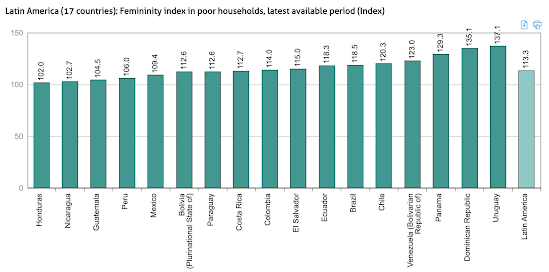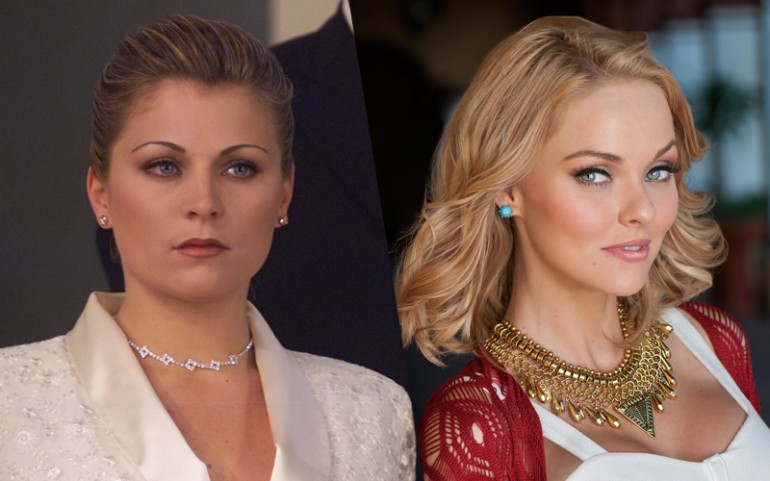The Feminization of Poverty
As we have been discussing in class recently, a lot of telenovelas build on the cinderella archetype whether that be through a classic telenovela rosa where the poor girl falls in love with the rich boy or another that is de ruptura that breaks that narrative while still calling back on it to make their point. There are a lot of answers to the question "Why Cinderella?" from our love of underdogs, wanting the aspirational to be reality or the fact that reversals of fortune resonate with many who are used to economic uncertainty. But a point that was made that really intrigued me was the global feminization of poverty and all the ties it has that connect back to telenovelas and cultural values.
Statistically speaking, more women are impoverished than men. This index shows how many times the incidence of poverty is greater among women than men in 17 different Latin American countries and spoiler: women are poorer than men in every single one. One of the points that the analysis below makes is that this shows that efforts to reduce poverty are not equally benefitting men and women, which will only perpetuate the cycle.
I think that the global phenomenon of feminizing poverty and all of that taking place in Latin America has a very strong connection to machismo and marianismo. Machismo calls for logic, lack of emotion, desire for dominance, and ambition. Marianismo calls for a heightened sense of morality, submissiveness, and nurturing. Both of these relate to power — the male gender in society is empowered (even to their own detriment) whereas women are told to step aside and play a supporting role.
With this in mind, it would make sense that women are more impacted by poverty in Latin America considering it would be harder and less likely for them to be breadwinners and put themselves in the driver's seat of their own lives without any opposition from a husband, family, coworkers, or anyone else. In this case, no wonder so many people find themselves gravitating toward the fantastical world of telenovelas where each unexpected twist and turn show a world full of endless possibilities.
So how does this all connect to telenovelas on a larger scale than just a quick point made about the cinderella archetype? I believe that the combination of machismo/marianismo massively contributes to the success of the cinderella archetype in telenovelas, especially in telenovelas rosas. We generally associate telenovelas with dramatics and being a bit far-fetched, some of these clips we watch feel so fictional. Take Marimar, for example. This is not the telenovela I am watching for this class but I believe it's a prime example. In the intro video, you can see clips of the titular character Marimar, who is a poor girl that lives in a hut with her grandparents, and Sergio, the son of a wealthy farmer. This intro looks exactly how I'd imagine a telenovela to be.
Despite the idealized shots of her leaving the ocean, rolling around with Sergio, and being carefree in a way that is almost painfully cinematic — the use of the Cinderella archetype is some basis in the reality of many Latin American women. With the knowledge that Latin American women are more affected by poverty and have more limited agency in terms of breaking that cycle themselves, the archetype's dependence on the privilege of a man is much more realistic than we initially realize. The cinderella archetype actually shows a reality that is both based on machismo/marianismo and draws upon the reality many women face, depicting it in a way that gives women an aspirational escape to a world with more possibility.


Hola Marillyn! Me intereso mucho tu blog post porque incluiste muchas estadísticas y explicastes el feminismo en las telenovelas y cómo se representan las mujeres, especialmente las que son en los arquetipos de "Cinderella" o "Rags to Riches". También me gusto que incluiste el machismo y el marianismo, porque creo que estos elementos son importantes en la conversación de feminismo en telenovelas. El demostracion del poder en las telenovelas es algo predominantemente evidente en los personajes de hombres, mientras que las mujeres necesitan ayuda o ser salvadas. Por eso me gusta mi telenovela, "La Reina Del Sur", porque mi personaje principal tiene su propia poder y hace todo por su misma. Ella representa el opuesto de las expectativas de las mujeres en telenovelas, y creo que los telespectadores aprecian que hay una mujer con mucho poder y fuerza.
ReplyDelete